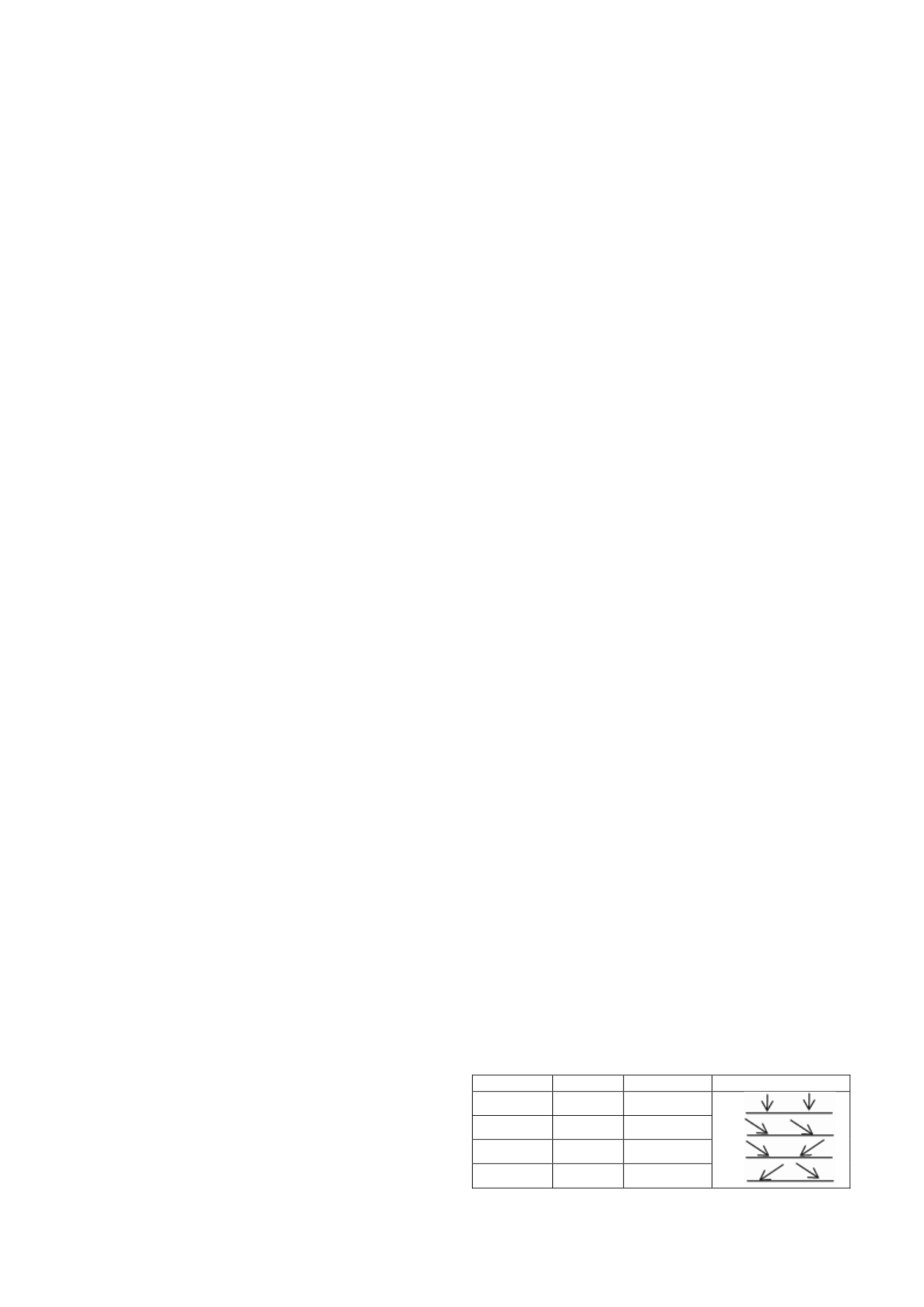
3459
Interaction of Nearby Strip Footings Under Inclined Loading
Interaction de semelles rapprochées soumises à des charges inclinées
Nainegali L.S., Ghosh P., Basudhar P.K.
Department of Civil Engineering, Indian Institute of Technology-Kanpur, India
ABSTRACT: An attempt is made to study the interaction of two closely spaced rigid strip footings resting on homogeneous soil bed
and find their ultimate bearing capacity (UBC) and settlement behaviour subjected to inclined loading. Finite element software
ABAQUS is used for the analysis. The foundation soil is modeled as elasto-plastic material obeying the Mohr-Coulomb failure
criterion. The soil domain is discretized with 4-noded bilinear plane strain quadrilateral elements. Parametric studies is performed by
varying the angle of inclination of load with horizontal (θ) and clear spacing (S) between the footings. Both bearing capacity and
settlement of interacting footings compared to that of an isolated footing increases with decrease in S for footings loaded vertically,
whereas the effect on UBC for footings with inclined load is not significant.
RÉSUMÉ : Une étude a été réalisée pour analyser l'interaction de deux semelles filantes rigides rapprochées appuyées sur un sol
homogène et déterminer la charge limite de rupture et les tassements lorsqu'elles sont soumises à une charge inclinée. Cette analyse a
été réalisée avec le logiciel d'éléments finis ABAQUS. Le sol de fondation est modélisé par un matériau élasto-plastique satisfaisant
le critère de Mohr-Coulomb. Les éléments de sol sont constitués de quadrilatères à 4 nœuds en contraintes planes. Des études
paramétriques ont été réalisées en faisant varier l'inclinaison de la charge (θ) et l'espace entre bords de fondations (S). Il apparait que
les capacités portantes et les tassements des fondations augmentent par rapport à ceux de fondations isolées lorsque l'espacement S
diminue pour des semelles chargées verticalement, alors que la capacité portante n'est pas affectée pour des charges inclinées..
KEYWORDS: Interference, Inclined load, Bearing capacity, Strip footings, Homogeneous soil.
1 INTRODUCTION
The classical or conventional theories developed for bearing
capacity and settlement of isolated shallow foundations have
been studied exhaustively by several researchers in the early
phase of the development of soil mechanics such as the theories
postulated by Terzaghi 1943, Meyerhof 1963, Vesic 1973, etc
have been a good representation of actual field conditions a few
decades ago. But there are situations such as railway sleepers
and foundations near the property lines wherein foundations are
closely spaced. Under such conditions the stress isobars of the
individual footings may interact and coalesce forming an
overlapped stress isobar affecting a larger zone of foundation
soil altering the behaviour of the individual foundations, which
would be different from that of the isolated footings. Therefore,
analysis of such problems should be carried out by considering
all the factors that govern the interference behaviour of such
closely spaced footings as realistically as possible. A number of
investigations have been performed numerically as well
experimentally to determine the interference effect of two
nearby shallow foundations. Stuart 1962 was the pioneer to
study the phenomenon effect on ultimate bearing capacity
(UBC) of two nearby strip footings using limit equilibrium
method. Most of the researchers (Graham et al. 1984, Kumar
and Ghosh 2007, Kumar and Kouzer 2007, Kumar and
Bhattacharya 2010, Mabrouki et al. 2010, Kouzer and Kumar
2010, Ghosh and Sharma 2010, Nainegali and Basudhar 2011,
Lee et al. 2008, Nainegali et al. 2012) used numerical methods
such as method of stress characteristics, upper or lower bound
methods, finite difference and finite element methods to study
the interference effect on UBC. Moreover laboratory model
experimental tests were conducted by Khing et al. 1992, Das et
al. 1993, Kumar and Sharan 2003, Kumar and Bhoi 2008,
Ghosh and Kumar 2009. Most of the literature available on the
subject is related to vertical loading however, in several
situations interacting footings are subjected to inclined loading
owing to vertical and horizontal loads transmitted through the
superstructure or inclined columns or wind load.
Therefore, in this paper, an attempt is made to study the
interaction of two closely spaced rigid strip footings resting on
homogeneous soil bed and find their ultimate bearing capacity
and settlement behaviour subjected to inclined loading.
2 PROBLEM DEFINATION
Two rigid strip footings designated as the left (B
L
) and the right
(B
R
) footing of symmetrical width, B rest on the surface of the
homogeneous soil layer of depth, H as shown in Figure 1. The
two footings are placed at a clear spacing, S and an inclined
load, P is applied at an angle of inclination θ
L
and θ
R
with
horizontal on the left and right footings, respectively. The effect
of angles of inclination of load (θ
L
and θ
R
) and the clear spacing
between the footings on the ultimate bearing capacity and
settlement are analyzed. The properties of the soil deposit are
considered as specified by Ghosh et al 2011 for the first layer of
soil deposit, wherein Young’s modulus of soil, E is 2.06e+03
kN/m
2
, Poisson’s ratio, µ is 0.3, cohesion, c
u
is 19.40 kN/m
2
,
soil friction angle, � is 24.73
0
, unit weight of soil, γ is 17
kN/m
3
and thickness of total soil deposit, H is 11.7 m. The
loading cases are chosen such that the variation of load
inclination leads to combination of symmetrical and
asymmetrical loading conditions. The cases of loading are given
in Table 1.
Table 1. Loading cases
Case
θ
L
θ
R
Layout
a
90
0
90
0
b
60
0
60
0
c
60
0
120
0
d
120
0
60
0


